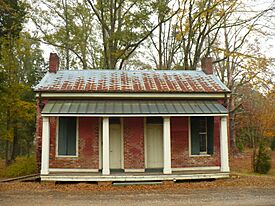Dayton, Alabama facts for kids
Quick facts for kids
Dayton, Alabama
|
|
|---|---|

The Boddie law office, now the Dayton Town Hall, completed in 1858
|
|

Location in Marengo County, Alabama
|
|
| Country | United States |
| State | Alabama |
| County | Marengo |
| Incorporated | January 13, 1844 |
| Area | |
| • Total | 1.00 sq mi (2.59 km2) |
| • Land | 1.00 sq mi (2.59 km2) |
| • Water | 0.00 sq mi (0.00 km2) |
| Elevation | 243 ft (74 m) |
| Population
(2020)
|
|
| • Total | 28 |
| • Estimate
(2022)
|
27 |
| • Density | 27.0/sq mi (10.44/km2) |
| Time zone | UTC−6 (Central (CST)) |
| • Summer (DST) | UTC−5 (CDT) |
| ZIP Code |
36738
|
| Area code(s) | 334 |
| FIPS code | 01-19912 |
| GNIS feature ID | 0117151 |
Dayton is a town in Marengo County, Alabama, United States. The population was 28 at the 2020 census.
History
Dayton began to be settled in the early 19th century, with a town survey done and a "public well" established in 1832. The post office was established in 1837. It was incorporated on January 13, 1844. A devastating tornado hit the town in 1852. By 1860 the town had male and female academies, a hotel, cotton gin, oil mill, blacksmith shop, tavern, cabinet shop, drug store, and several general merchandise stores. The town also had several large homes, though most are now gone. One of the survivors, the William Poole House, is listed on the National Register of Historic Places. The decrease in agricultural activity over the last century has reduced the population to a fraction of what it once was.
Geography
Dayton is located in northeastern Marengo County at 32°20′59″N 87°38′28″W / 32.34972°N 87.64111°W (32.349733, -87.641247). It is 11 miles (18 km) northeast of Linden, the county seat, and 20 miles (32 km) southeast of Demopolis, the largest city in the county.
According to the United States Census Bureau, Dayton has a total area of 1.0 square mile (2.6 km2), all land. The town sits on a ridge that drains southeast to Dry Creek and northwest to Little Dry Creek, both tributaries of Chickasaw Bogue, which flows west across the county to the Tombigbee River.
Demographics
| Historical population | |||
|---|---|---|---|
| Census | Pop. | %± | |
| 1870 | 426 | — | |
| 1880 | 473 | 11.0% | |
| 1890 | 412 | −12.9% | |
| 1900 | 427 | 3.6% | |
| 1910 | 382 | −10.5% | |
| 1920 | 245 | −35.9% | |
| 1930 | 202 | −17.6% | |
| 1940 | 153 | −24.3% | |
| 1950 | 85 | −44.4% | |
| 1960 | 99 | 16.5% | |
| 1970 | 115 | 16.2% | |
| 1980 | 113 | −1.7% | |
| 1990 | 77 | −31.9% | |
| 2000 | 60 | −22.1% | |
| 2010 | 52 | −13.3% | |
| 2020 | 28 | −46.2% | |
| 2022 (est.) | 27 | −48.1% | |
| U.S. Decennial Census 2020 Census |
|||
2020 census
| Race / Ethnicity (NH = Non-Hispanic) | Pop 2010 | Pop 2020 | % 2010 | % 2020 |
|---|---|---|---|---|
| White alone (NH) | 17 | 10 | 32.69% | 35.71% |
| Black or African American alone (NH) | 34 | 18 | 65.38% | 64.29% |
| Native American or Alaska Native alone (NH) | 0 | 0 | 0.00% | 0.00% |
| Asian alone (NH) | 0 | 0 | 0.00% | 0.00% |
| Pacific Islander alone (NH) | 0 | 0 | 0.00% | 0.00% |
| Some Other Race alone (NH) | 0 | 0 | 0.00% | 0.00% |
| Mixed Race or Multi-Racial (NH) | 1 | 0 | 1.92% | 0.00% |
| Hispanic or Latino (any race) | 0 | 0 | 0.00% | 0.00% |
| Total | 52 | 28 | 100.00% | 100.00% |
As of the 2020 census, there were 28 people, 7 households, and 4 families residing in the city. There were 12 housing units.
Climate
The climate in this area is characterized by hot, humid summers and generally mild to cool winters. According to the Köppen Climate Classification system, Dayton has a humid subtropical climate, abbreviated "Cfa" on climate maps.
Notable people
- Sarah Byrd Askew, public librarian who pioneered the establishment of county libraries in the United States
- Bill Poole, politician
See also
 In Spanish: Dayton (Alabama) para niños
In Spanish: Dayton (Alabama) para niños


